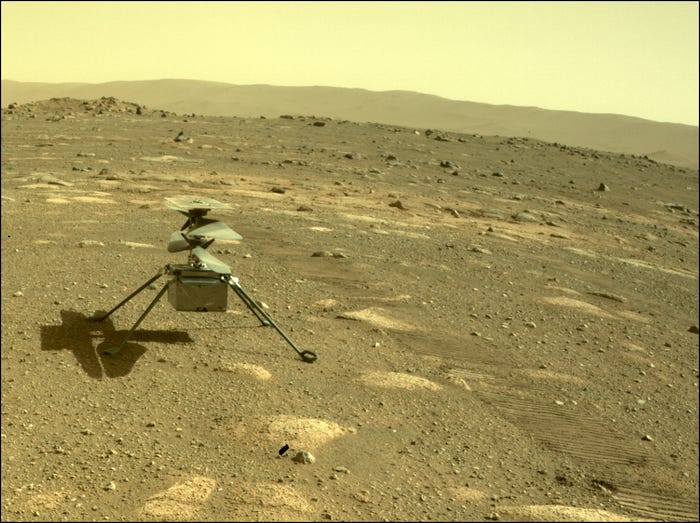We’ve already seen NASA’s Ingenuity helicopter fly on Mars — and now we can hear it, too.
The whirring of Ingenuity’s fast-spinning rotors was captured by NASA’s Perseverance rover during the little chopper’s fourth Red Planet flight, which took place on April 30, according to NASA officials today (May 7).
The newly released video, which was made with Perseverance’s rock-zapping SuperCam instrument’s microphone, is the first time one spacecraft has recorded audio of another probe on a planet beyond Earth. According to members of the rover team, it has more than just gee-whiz value.
The nearly three-minute-long video begins with the low rumble of the wind blowing across the Jezero Crater, where Perseverance landed in February on a mission to search for signs of ancient microbial life.
Ingenuity then takes off, and its blades can be heard humming softly as they spin at nearly 2,400 rpm on the 872-foot (262 meter) roundtrip.
The mission’s engineers weren’t sure they would pick up the flight sound at all, given that Perseverance was parked 262 feet (80 meters) aware from the takeoff and landing spot.
The Martian atmosphere is about one percent the density of our planet’s, making everything much quieter than on Earth.
“This recording will be a gold mine for our understanding of the Martian atmosphere,” SuperCam microphone science lead David Mimoun, a professor of planetary science at Institut Supérieur de l’Aéronautique et de l’Espace (ISAE-SUPAERO) in Toulouse, France, said in a statement.
Perseverance carries two microphones — the SuperCam instrument mic and one that’s part of the rover’s entry, descent and landing camera system. Prior to April 30, both mics had already captured audio, making these the first-ever sound recordings made on Mars’ surface.
“This is a very good surprise,” said David Mimoun “We had carried out tests and simulations that told us the microphone would barely pick up the sounds of the helicopter, as the Mars atmosphere damps the sound propagation strongly. We have been lucky to register the helicopter at such a distance.” he added.
NASA made the audio, which was recorded in mono, easier to hear by isolating the pitch of the helicopter blades at 84 hertz, then reducing audio at frequencies below 80 and above 90 hertz. They then increased the volume of the remaining signal.
Soren Madsen, Perseverance payload development manager at NASA’s Jet Propulsion Laboratory, said the recording was an example of how the mission’s instruments are able to work in tandem to enhance our understanding of the Red Planet.
As Ingenuity moves away from Perseverance and out of shot, the pitch decreases and as it returns the pitch increases.
This is known as the Doppler Effect, and it provides an additional layer of confirmation of the helicopter’s flight path when it is out of visual range.
READ MORE: An Interactive Map Shows Exactly Where NASA’s Rover Perseverance Is
No products found.



We spent a lot of money so these people could fly a mostly useless drone on Mars. Surely that money could have been better spent.